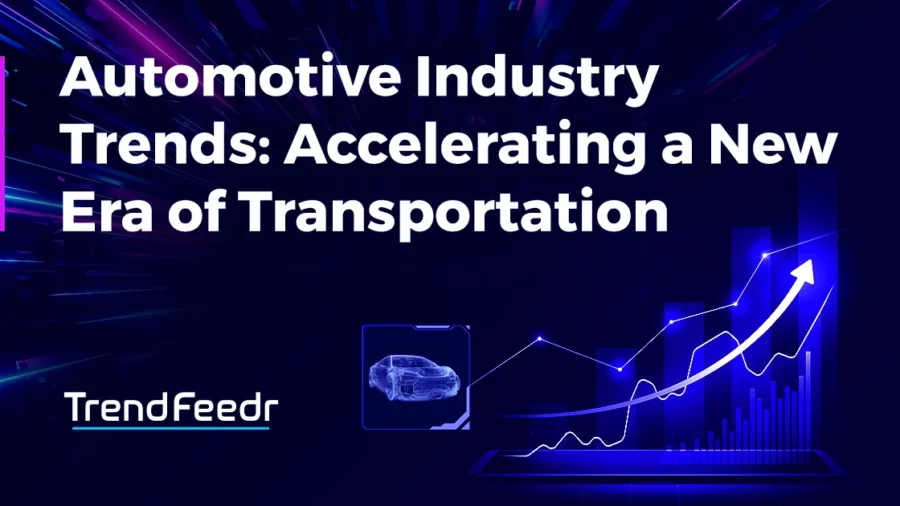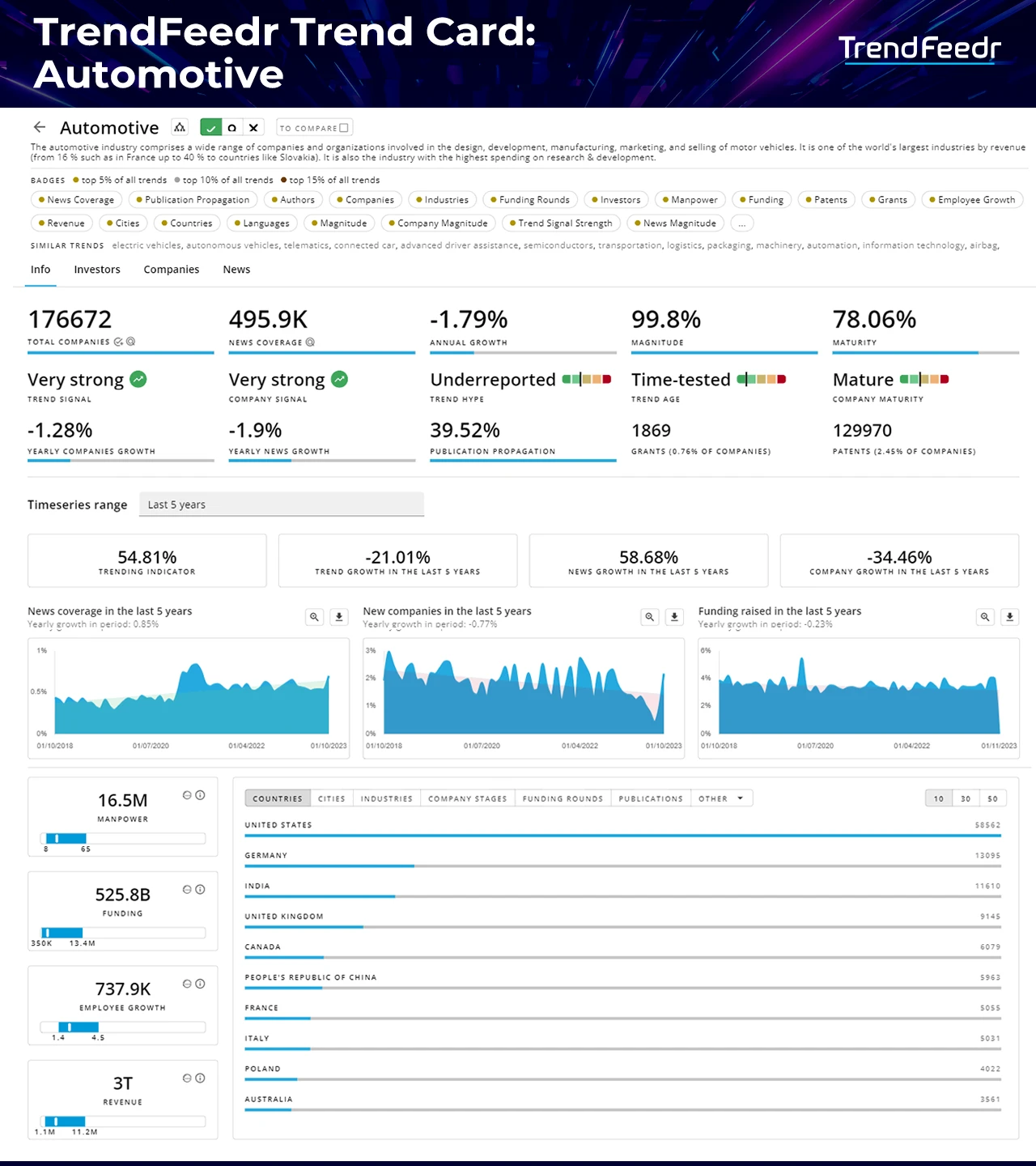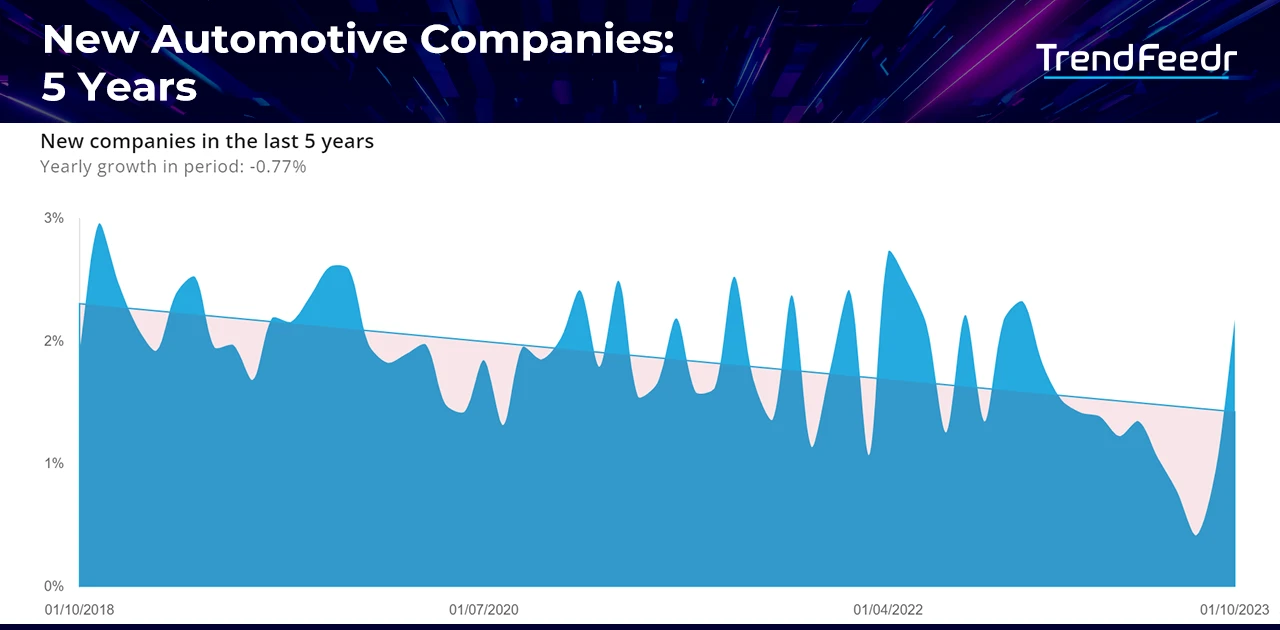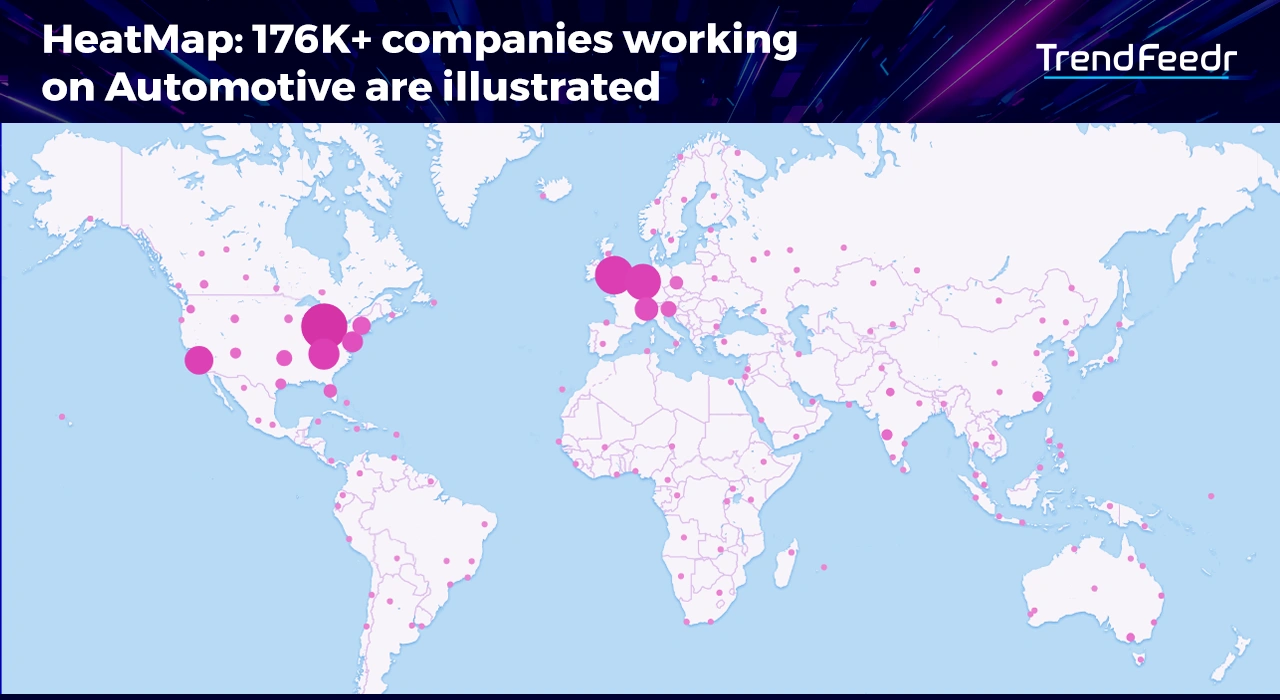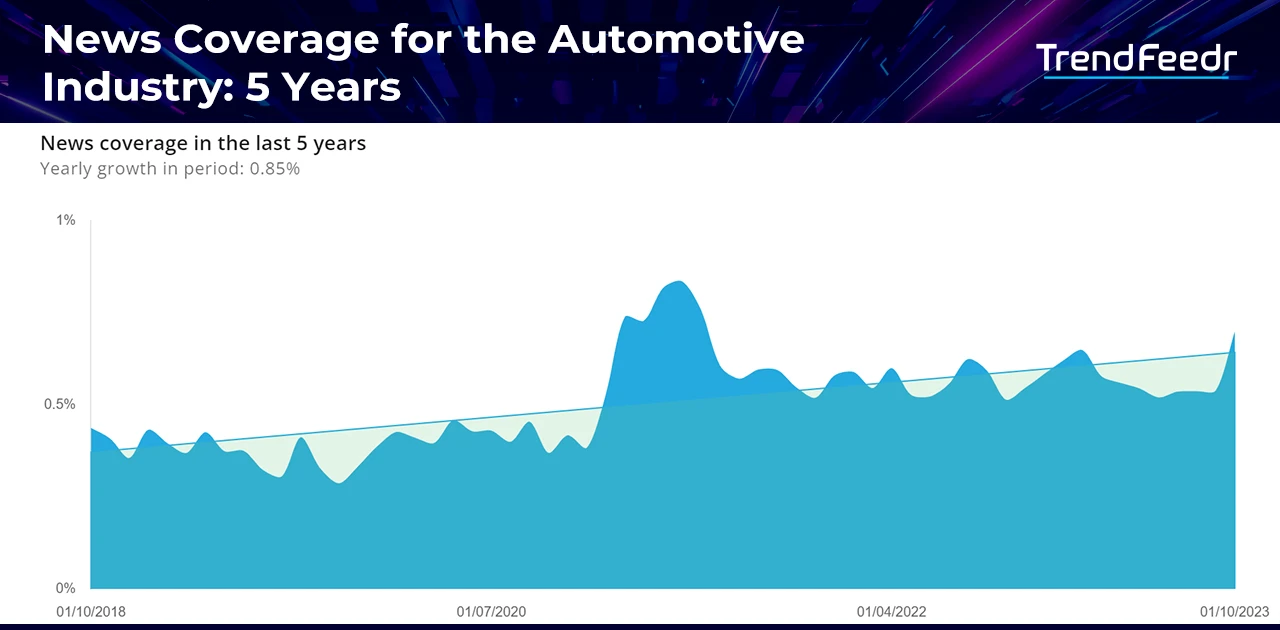This automotive report highlights emerging automotive industry trends shaping an exciting and revolutionary future. They are ushering in a new era where vehicles converse with each other to evade accidents and electric powertrains significantly diminish carbon footprints. Imagine urban environments devoid of traffic congestion, made possible by intelligent transportation systems, or the exhilarating experience of being a passenger in an autonomous vehicle.
Recent breakthroughs are dramatically reshaping the transportation landscape. This encompasses the incorporation of artificial intelligence in vehicle engineering, advancements in battery technology, and the extensive implementation of connectivity solutions.
Supporting these innovations and automotive market trends are persuasive data points. A recent study by Precedence Research valued the global automotive motors market at US$28 billion in 2022, with a projected growth of approximately US$42.86 billion by 2032. This represents a compound annual growth rate (CAGR) of 4.4% from 2023 to 2032. Moreover, EV adoption in the US is projected to skyrocket to 30% by 2030, with a global penetration of 41%, according to PwC’s auto industry prediction.
In this data-driven automotive report, we delve into the current trends in the automotive industry, including electric vehicles, autonomous vehicles, telematics, connected cars, and advanced driver assistance systems.
Key Takeaways
- Dominant Trend: The automotive industry, with a trend magnitude of 99.8% and maturity of 78.06% according to TrendFeedr, exerts a significant influence and exhibits a solid growth trajectory across global markets.
- Broad Spectrum: Automotive firms are actively participating in emerging trends such as electric vehicles, autonomous vehicles, telematics, connected cars, and advanced driver assistance systems (ADAS), thereby transforming the transportation ecosystem.
- Media Attention: Over the past five years, there has been a steady increase in automotive industry news coverage by 0.85%, indicating continuous media engagement and public interest.
- Investment Hub: The automotive sector is a hive of activity with around 176,000 organizations attracting significant investments, with total funding nearing US$500 billion.
- Financial Backing: Major investment firms like Warburg Pincus, Goldman Sachs, and SoftBank Vision Fund are investing heavily in the automotive future, directing billions of dollars into innovative projects that aim to revolutionize mobility.
- Geographical Influence: The automotive trend has a strong foothold in key markets such as the United States, Germany, India, the United Kingdom, and Canada. Furthermore, cities like Bangalore, London, New York City, Mumbai, and Melbourne are identified as major hubs driving automotive advancements and contributing to the global spread of the trend.
Table of Contents
-
- Understanding Automotive Industry Trends
- Automotive Industry Trend Card
- Emerging Technologies Disrupting the Automotive Industry
- Key Automotive Industry Trends
- 5 Emerging Automotive Companies
- Automotive Investment Trends
- Mapping the Geographical Activity
- Media Coverage of the Automotive Industry
- Automotive Industry Future Outlook
For this detailed analysis of emerging automotive industry trends, we use TrendFeedr, our all-in-one trend intelligence platform. TrendFeedr uses advanced algorithms to identify future industry and tech trends. With a focus on trend discovery, clustering, and analysis, the AI-powered platform reviews thousands of trends each week to provide actionable insights.
Among more than 20,000 trends and technologies monitored by TrendFeedr, automotive has made a significant impact. Here’s why:
- Automotive lands in the top 50 trends, and it ranks within the top 1% of global trends, demonstrating its significant evolution and integral role in the world economy.
- With a maturity of 78.06%, the automotive industry has surpassed its initial stages of innovation and now finds itself in a phase of refinement and consolidation. This stage is characterized by steady growth, established methodologies, and a clear path towards future development.
- The extensive influence of this industry is revolutionizing transportation, manufacturing, and urban planning sectors. It is driving progress in electric vehicles, hybrid cars, and autonomous vehicles, steering them towards sustainability and environmental friendliness.
This report explores various aspects of the automotive industry, including performance, investment, regional, and future outlook.
Understanding Automotive Industry Trends
Positioned at the intersection of innovation and sustainability, a plethora of trends in the automotive industry, are reshaping our understanding and interaction with vehicles. These trends, deeply anchored in technological progress and a shift in consumer preferences, are heralding a new epoch in transportation. Let’s delve into these trends and explore emerging technologies in the automotive industry.
What are trends in automotive?
The automotive industry is in the midst of a significant transformation, with several key trends reshaping transportation. One of the most influential trends is the shift towards electrification, driven by a global emphasis on reducing carbon emissions and conserving fossil fuels. Automakers worldwide are enhancing their EV offerings, promising longer ranges and faster charging times at more affordable price points. Alongside this, strides are being made in the domain of autonomous driving. Features like lane-keeping assistants, adaptive cruise control, and self-parking are already being integrated into consumer cars.
Today’s vehicles are increasingly becoming connected hubs, thanks to advancements in connectivity and infotainment systems. With vehicle-to-vehicle (V2V) and vehicle-to-infrastructure (V2I) communication, the driving experience is becoming more interactive and informed. Additionally, the concept of vehicle ownership is evolving, with younger generations leaning more toward shared mobility solutions. These include car-sharing, ride-hailing, and even shared ownership. Beyond just vehicles, there is also a focus on making the manufacturing process greener through the use of sustainable materials, waste reduction, and supply chain optimization for minimal environmental impact.
What are new technologies in the automotive industry?
A host of emerging technologies serve as the backbone for the trends mentioned above. In the realm of battery technology, advancements in lithium-ion and solid-state batteries are enhancing the range of EVs, reducing charging times, and bringing down costs. AI and machine learning are enabling better driver assistance systems and predictive maintenance. They are playing a pivotal role in the development of autonomous vehicles. The global rollout of 5G networks is enhancing vehicle connectivity, enabling real-time data sharing between vehicles and infrastructure.
Advanced driver assistance systems (ADAS), using a combination of cameras, radars, and sensors, offer features like automatic braking, pedestrian detection, and blind-spot monitoring. This significantly enhances road safety. Furthermore, the use of lightweight materials such as carbon fiber, advanced alloys, and composite materials is reducing vehicle weight. This leads to improved fuel efficiency and performance.
Automotive Industry Trend Card: Concise Overview of the Evolving Automotive Landscape
In our ongoing series examining key industry sectors, today we zero in on the automotive industry — a vast arena characterized by intensive innovation and substantial economic heft. The Trend Card at hand provides more valuable insights:
Looking for all trends related to Automotive?
- Market Dynamics: The automotive sector, home to 176,672 companies, shows a slight decline in year-over-year growth, indicative of a competitive yet maturing market.
- Media Presence: Exhibiting robust media coverage with a ‘very strong’ signal status, the industry nonetheless faced a 1.79% dip in yearly news growth.
- Innovation and Development: An impressive trend magnitude of 99.8% places the automotive industry firmly as an established, time-tested sector. With a maturity level of 78.06%, it remains ripe for growth and innovation, ranking in the top 1% of global trends.
- Intellectual Property: Holding 129,970 patents, the industry emphasizes a deep commitment to research and development, driving continuous innovation.
- Industry Dynamics: Over the past five years, there’s been a 58.68% increase in media coverage of investments, contrasting with a 21.01% decrease in new company formation and a 34.46% reduction in funding.
- Human Capital: Manpower stands at 16.5 million, underpinning the industry’s scale.
- Financial Confidence: With total funding reaching US$525.8 billion, the industry displays robust financial backing and confidence in its future trajectory.
- Global Footprint: The United States leads in the country ranking, followed by key players like Germany, India, and the United Kingdom, illustrating a diverse geographic distribution of automotive prowess.
Stay with us as we delve deeper into our exploration, we will dissect each aspect, providing insights and thorough analysis.
How Do Emerging Technologies Disrupt the Automotive Industry?
Emerging technologies are revolutionizing the automotive industry, paving the way for a safer, more efficient, and more sustainable future. In this section, we will explore in greater depth about these automotive technologies:
Electric Vehicles (EVs)
EVs are disrupting the automotive industry by offering a cleaner and more sustainable alternative to traditional gasoline-powered vehicles. They produce zero emissions and are increasingly seen as a key solution to reducing the carbon footprint and combating climate change.
Companies such as Munro Vehicles create specialist electric 4×4 vehicles with HV compressors that condition the powertrain, battery, and cabin across a wide range of temperatures. Its electric drive systems provide maximum traction off-road while producing zero tailpipe emissions.
Autonomous Vehicles (AVs)
By using advanced sensors and artificial intelligence, autonomous vehicles navigate without human drivers. AVs are set to transform the way people travel, potentially making roads safer and more efficient.
For instance, companies like Motional use sensors and artificial intelligence to navigate without human drivers. Its IONIQ 5 robotaxis are used for both driverless ride-hail and delivery. The startup’s driverless vehicle technology makes autonomous vehicles a safe, reliable, and accessible transportation solution.
Telematics
Telematics increases road safety, improves driving behavior, and enables transportation companies to monitor their assets using GPS. This technology onboard diagnostics to record data such as driving habits, geographical locations, and irregularities that could lead to accidents.
For example, Brightmile uses telematics to incentivize eco-driving and lower CO2 emissions. Its platform offers a way for fleet managers to engage drivers and improve driving habits while also achieving sustainability targets. By tracking metrics like speeding, phone use while driving, and fatigue, the company provides insights and coaching to drivers.
Connected Cars
Leveraging advanced technologies such as the IoT, AI, and cloud computing, connected cars offer enhanced connectivity, real-time data exchange, and smarter in-vehicle experiences. It delivers real-time instructions to vehicles, reducing congestion and lowering costs.
Eloy, for instance, provides solutions to improve traffic management for large events and destinations through connected vehicle technology. Its products help traffic managers and drivers plan routes more intelligently and deliver real-time instructions to vehicles.
Advanced Driver Assistance Systems (ADAS)
ADAS utilizes a combination of sophisticated sensors, cameras, and algorithms to significantly enhance vehicle safety. These advancements lead to a reduction in accident rates and an improvement in driving comfort.
Companies such as Roadio develop automotive-level ADAS for small vehicles like motorcycles and scooters. Its system pairs with a smartphone app to give riders a real-time view of their surroundings. It uses cameras and neural networks to reconstruct the vehicle’s 3D environment, eliminating blind spots and providing early warnings of potential collisions.
In conclusion, these emerging technologies are not only disrupting the automotive industry but also shaping its future. As these technologies continue to evolve, we can expect to see even more innovative solutions transforming transportation systems.
Key Automotive Industry Trends & Firmographic Insights
The automotive industry is undergoing a monumental shift, driven by cutting-edge innovations and a diverse array of organizations. With over 16.5 million professionals contributing their expertise, this sector is a melting pot of large-scale enterprises and agile startups.
The average company size of 131 employees juxtaposes with a median of just 21, highlighting a landscape where industry giants coexist with niche players. The influx of 737.9K new employees, averaging 7 per company annually, paints a picture of an industry in constant flux, balancing aggressive expansion with cautious growth. As we dive into the latest data from TrendFeedr, let’s explore how over 176,000 companies are steering the future of automotive through pioneering trends:
1. Electric Vehicles (EVs)
- Powered by an electric motor using energy stored in rechargeable batteries, EVs mark the evolution of the automotive industry towards sustainable and eco-friendly transportation.
- A staggering 29K organizations are delving into this cutting-edge trend, collectively gathering a substantial US$299.5 billion in funding.
- Driven by a dynamic workforce of 2.7 million individuals, these organizations are reshaping the future of green transportation.
2. Autonomous Vehicles (AVs)
- AVs, also known as self-driving cars, embody the convergence of sensors, cameras, and AI to navigate and control the vehicle without human intervention.
- A specialized yet impactful 8,363 organizations are driving this trend, attracting a robust US$140.9 billion in funding.
- These entities, supported by 808K professionals, are committed to creating safer and more efficient roads.
3. Telematics
- Telematics combines telecommunications and informatics to enhance vehicular functionalities, ranging from GPS to real-time monitoring, enhancing operations and efficiency.
- A total of 5,213 progressive organizations have ventured into this domain, securing an impressive US$27 billion in funding.
- With a unified team of 334.2K professionals, these institutions are leading the charge in optimizing vehicle safety.
4. Connected Car
- This trend highlights the integration of internet connectivity into vehicles, enabling them to share data with devices both inside and outside the vehicle.
- A total of 1,925 forward-thinking organizations are exploring this trend, collectively raising US$21.5 billion in funds.
- Supported by a team of 197.3K individuals, these entities offer solutions that redefine the boundaries between technology and transportation.
5. Advanced Driver Assistance Systems (ADAS)
- Employing technologies such as sensors and cameras to offer features like adaptive cruise control, automated braking, and lane departure warnings, ADAS enhances vehicle safety and assists drivers.
- 1,011 innovative organizations are embracing this trend, raising an impressive US$22.2 billion.
- With a combined force of 208.1K committed experts, these organizations are pioneering safety-first approaches in vehicular navigation.
The automotive industry is unmistakably on the brink of a groundbreaking transformation, fueled by these pivotal trends and the extensive network of organizations propelling them. Each trend carries its potential, challenges, and unique innovation landscape, playing a significant role in the redefinition of mobility and transportation as we currently understand it.
Emerging Automotive Companies Leading The Way
In the past five years, there has been a marginal downturn in the influx of new entrants in the sector. This is marked by a negative growth rate of 0.77%. The pattern indicates a phase of consolidation within the industry, where incumbent entities maintain their stronghold. The high entry barriers could be attributed to the matured market conditions, substantial capital requirements, or technological complexities.
5 Promising Automotive Startups
Moreover, automotive startups are propelling innovation at an unprecedented rate, unveiling revolutionary solutions that are transforming the facets of vehicle design, manufacturing, and operation. These startups are pioneering advancements in areas such as electric powertrains, autonomous driving technologies, connected car systems, and sustainable materials. With this, they are addressing some of the most pressing challenges in the industry. Let’s delve into the top five automotive startups established in the last five years that are making significant strides in shaping the future of transportation.
- CARIAD is an automotive software company that creates digital features for vehicles, including ADAS solutions, infotainment platforms, and software for powertrains and charging technology.
- TruTrak provides vehicle tracking & GPS tracking systems for individual vehicles to small and large fleets.
- Carnomaly develops blockchain solutions for the automotive industry, specifically for buying, selling, and owning cars.
- EV Electra is an electric automotive manufacturing and distribution company that is engaged in the R&D of electric vehicles.
- Linkbycar builds a platform for connected vehicle intelligence, collecting, processing, and aggregating data from a variety of vehicles.
Automotive Industry Investment Trends
The financial support for innovations and advancements in the automotive sector places it in the top 5% of all 20K+ trends and technologies covered by TrendFeedr.
In the past five years, there has been a marginal decline in the annual growth of automotive funding, averaging 0.23%. This minor decrease suggests a phase of stability or strategic consolidation within the industry. It could be indicative of companies potentially redirecting their attention toward enhancing the efficiency of their existing investments and resources.
A Closer Look at the Financials
TrendFeedr data indicates that the automotive sector has received a substantial total investment of US$525.8 billion. This amount is distributed across various entities, with Detroit Electric emerging as the top beneficiary, securing a maximum of US$1.8 billion. On average, automotive organizations received around US$46.5 million. However, the median figure, which arguably provides a more accurate representation of the majority, is at US$1.7 million.
In terms of revenue, TrendFeedr estimates that the automotive industry has generated a total of approximately US$3 trillion. Leading the pack, Young Shine reported the highest revenue of US$2.5 billion. While the average revenue across companies is around US$23.3 million, the median revenue is US$3.5 million.
A noteworthy 6.39% of automotive companies have secured essential capital to drive their innovation and expansion. Out of all the funding types, early-stage VC/series A funding rounds have emerged as a cornerstone. It provides budding startups with the financial support they require during their formative stages of growth. Seed funding has served as the vital initial investment for emerging automotive ventures, laying the groundwork for future innovation. Debt financing has offered a dependable financial safety net, ensuring consistent cash flow and operational continuity. Venture rounds have proven to be catalysts in propelling growth, enabling automotive firms to scale swiftly. M&A activities have paved the way for strategic partnerships and acquisitions, promoting cooperation and amalgamation within the industry. Furthermore, grants have left a significant imprint, with 1,869 grants awarded, benefiting 0.76% of automotive firms. This highlights the importance of public and private backing in nurturing automotive innovation.
Prominent Investors in the Automotive Industry
Warburg Pincus, a distinguished investment firm, is at the forefront of this investment movement. It has shown a strong commitment to the sector, with a substantial investment of US$2.2 billion distributed across 19 ventures. Their significant investment in Tata Technologies of US$360 million is particularly noteworthy.
Goldman Sachs has also made substantial contributions to the automotive industry. It has invested US$1.5 billion in 19 different automotive enterprises, with major stakes in Rimac at US$268.4 million and Northvolt at US$251 million. These investments reflect their confidence in the future of electric mobility and advanced automotive technologies.
The SoftBank Vision Fund, renowned in the tech investment sphere, has allocated a considerable US$1.4 billion to 8 selected projects within the automotive sector. Its top investment includes US$360 million in Carro.
In the public sector, investments have been more diverse but equally impactful. A staggering US$23.3 billion has been committed to 424 companies. Notable recipients include Longsys with US$345.7 million.
Further, the automotive industry’s immense potential is evident in the impressive number of unique investors it attracts, placing it among the top 5% of all global trends.
Mapping the Geographical Activity of Automotive Companies
The global landscape of the automotive industry presents a dynamic distribution, demonstrating a diverse dispersion across various continents while underscoring regions of intense activity. The heatmap below encapsulates over 176,000 entities within the automotive sector.
Interested in exploring all 176K+ automotive companies?
The United States continues to lead the global automotive sector, a testament to its long-standing history of automotive innovation and its array of esteemed car manufacturers. Germany closely follows, globally acclaimed for its luxury car manufacturers and remarkable engineering achievements. India has firmly established itself as a key player in the global arena, thanks to its expanding consumer base and thriving automotive hubs. The United Kingdom, with its iconic brands and pioneering automotive tech startups, continues to shape the industry. Canada rounds out the top tier of influential regions with its focus on sustainable automotive solutions.
Bangalore, known as India’s tech hub, has become a hotbed for automotive startups, positioning it as a nucleus of automotive innovation. London, in contrast, skillfully integrates its traditional automotive businesses with modern tech firms, securing its place on the global automotive landscape. Further, New York City and Mumbai have recently seen modest growth in this sector. Melbourne, with its rich history in car manufacturing, continues to contribute to the automotive industry.
Media Coverage of the Automotive Industry Sees a Yearly Uptick of 0.85% over the Last 5 Years
In the past five years, the automotive industry has demonstrated a consistent growth trajectory with an annual rate of 0.85%. This steady progression underscores the ongoing engagement and expanding discourse around automotive trends, technological breakthroughs, and innovative practices.
The surge in media attention for automotive industry trends is indeed noteworthy, earning it a place in the top 5% of all trends. The number of articles dedicated to this subject from 2005 to 2023 is an impressive 495,932, situating it within the top 5% of all global trends.
What is the Future of the Automotive Industry?
The automotive industry, brimming with innovative advancements and technological amalgamations, is poised for a paradigm shift in the forthcoming years. Based on the current landscape and data-driven insights, here’s the automotive industry outlook:
Sustainability beyond Electrification
While EVs persist in their stride toward market supremacy, the automotive industry’s approach to sustainability will diversify. We can anticipate an intensified effort towards fabricating vehicles with recyclable materials and adopting eco-friendly manufacturing procedures. The focus will be on a vehicle’s entire lifecycle, striving to minimize its carbon footprint from production to disposal.
Seamless Integration with Smart Cities
With the metamorphosis of urban areas into smart cities, vehicles will become an integral component of the urban ecosystem. We can anticipate automobiles interacting with traffic signals, parking lots, and even buildings, enhancing traffic management, alleviating congestion, and promoting efficient infrastructure utilization.
Smart Manufacturing
Digital transformation equips automotive manufacturers with the ability to automate production processes, streamline supply chain management, and reduce costs. Leveraging Internet of Things (IoT) devices, AI, and machine learning (ML), manufacturers will monitor production lines in real-time and identify potential issues before they lead to downtime.
Self-Navigating Vehicles
Automakers develop self-driving cars that operate without human intervention. Autonomous vehicles have the potential to revolutionize transportation by reducing accidents, traffic congestion, and emissions. In the future, many urban commutes will be in self-navigating vehicles. This shift will not only change the way we travel but will also reshape urban infrastructure, insurance sectors, and traffic management systems.
Evolving Retail Models
The automotive industry is moving away from traditional showrooms and embracing digital showrooms. The traditional car dealership model will transform. With augmented reality (AR) and virtual reality (VR), consumers might experience and customize their vehicles from the comfort of their homes. Direct-to-consumer sales models will also see growth.
Automotive Trends: Navigating the Future of Transportation
As we wrap up the automotive report, it is clear that we are moving through a rapidly changing landscape. The pace of discoveries is fast, and the range of possibilities seems endless. Keeping up with these changing trends is very important. It allows you to anticipate changes, take advantage of new opportunities, and stay ahead. But how do you do that?
Connect with automotive enthusiasts, industry leaders, and innovative creators; their insights can provide valuable perspectives and open up opportunities for collaboration. Dive into reports specific to the sector, attend automotive-focused seminars and conferences, and participate in online automotive communities. Also use trend-tracking tools like TrendFeedr that meticulously track up to 207 sub-trends, offering a comprehensive view of the evolving automotive industry landscape.

